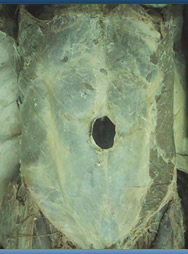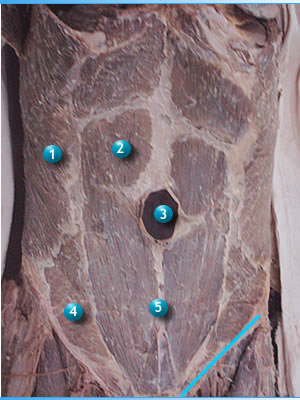| Organization of the antero-lateral
abdominal wall |
|
| Boundaries |
|
 |
Superiorly:
- Xiphoid process.
- Costal cartilages of the 7th and 10th ribs.
Inferiorly:
- Iliac crest.
- Anterior superior iliac spine.
- Inguinal ligament.
- Pubic tubercle, pubic crest and pubic symphysis.
Divided into 4 quadrants i.e
- Right and left upper quadrants
- Right and left lower quadrants
|
| |
|
| Divisions of
the abdomen |
 |
Can be Divided into 9 regions.
- Two vertical planes- midclavicular
- Two horizontal planes:
- Subcostal plane – joining the most inferior points
of the costal margins, and passing at L3.
- Transtubercular plane, joining the tubercles
of the iliac crest.
|
| |
| Note the 9 regions. |
- Right and left hypochondrial regions (1and
3)
- Middle epigastric region (2)
- Right and left lumbar regions (6
and 4)
- A middle umbilical region (5)
- Right and left iliac (inguinal) region (7and
9)
- A middle hypogastric or suprapubic region
(8)
|
| |
|
Layers of anterior abdominal
wall |
- Skin
- Superficial fascia: Fatty and membranous
- Deep fascia
- Muscles:
- Extra peritoneal tissue
- Peritoneum.
|
| |
|
Skin |
- Shows ‘creases' which represent
the lines of orientation of collagen fibres in the dermis- Langer's
lines.
- These lines are surgically important – incisions along them
heal better leaving a thin scar; while those across them leave big scars.
- In pregnant women, obese people and those with abdominal
distention from whatever cause, there are dark elongate lines called
striae gravidara.
- The skin is very sensitive to touch, and quickly when touched,
the muscles contract.
|
| |
|
| Superficial
fascia |
| 
|
Consists of two layers;
- Fatty layer (Camper's fascia)
containing variable amounts of fat, more in females and in the lower
abdomen.
- Membranous layer (Scarpa's
fascia).
(+) Contains fibrous tissue and very little
fat.
(+) Fuses with fascia lata below inguinal ligament)
(+) Continuous
with the superficial perineal fascia (Colle's fascia) and with that
investing the scrotum and penis.
|
| |
|
| Deep fascia |
Unremarkable |
| |
|
| The muscles |

|
There are 4 main muscles to note:
- External oblique
- Internal oblique
- Transversus abdominis
- Rectus abdominis
Note the attachment and innervation of these muscles.
|
| |
| Functions of the muscles: |
- Support and protection for abdominal viscera
- Movement of the trunk – flexion, extension, twisting
and lateral bending.
- Maintenance of posture
- Increase intra abdominal pressure in functions such
as defecation, micturition and parturition etc.
|
| |
|


